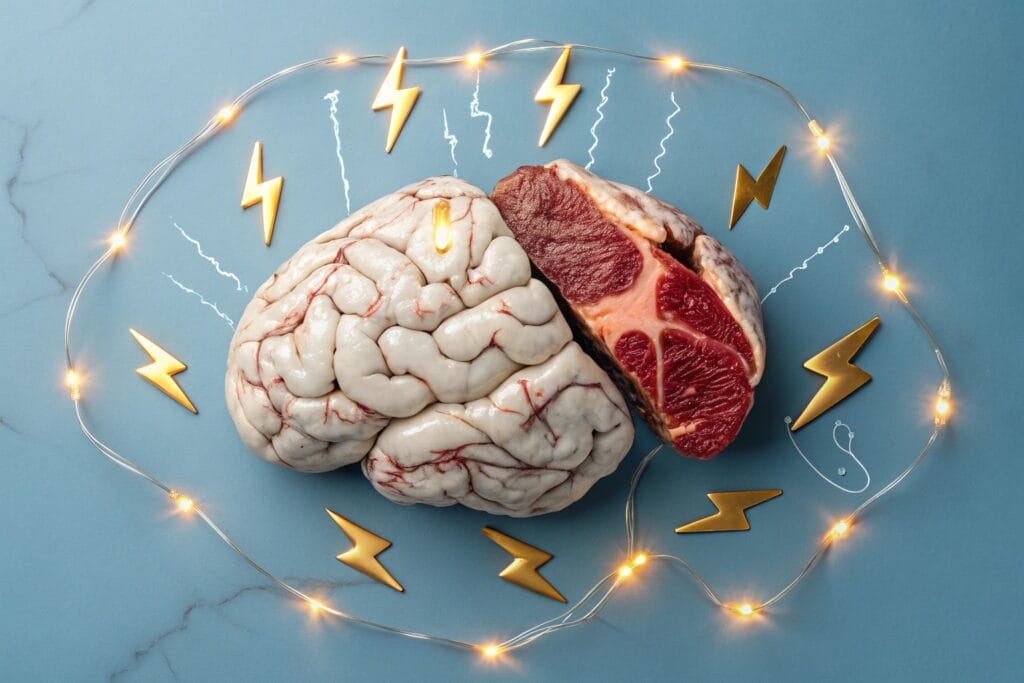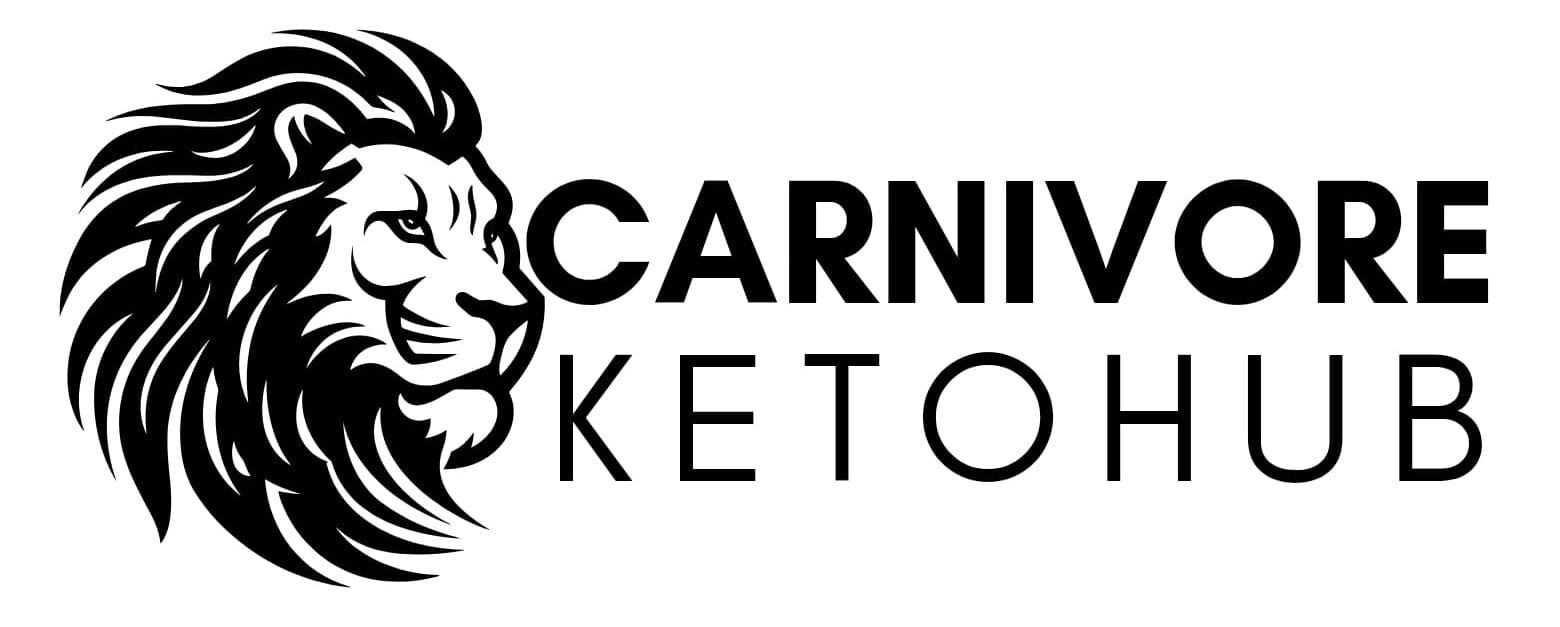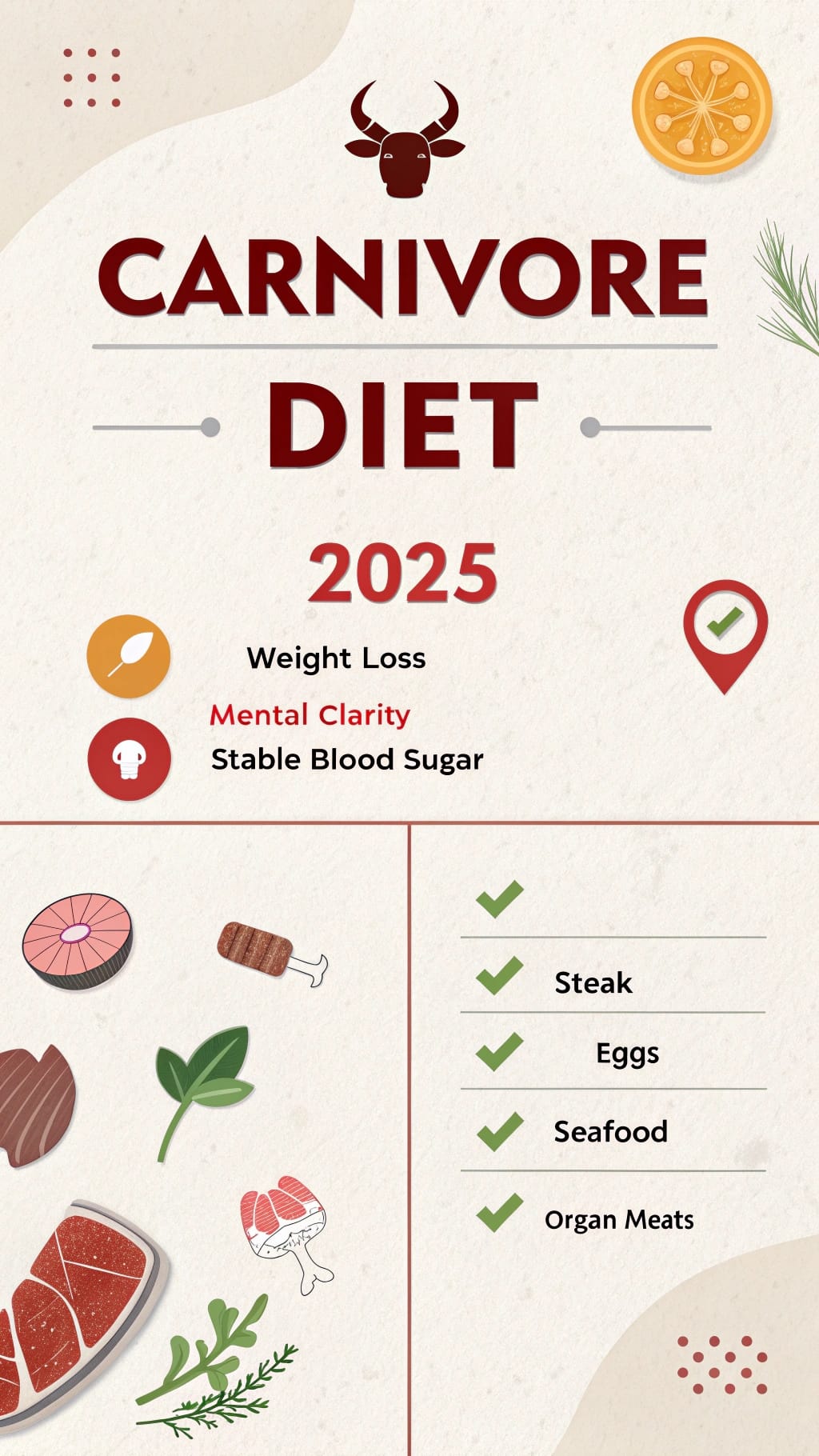The Ultimate Beginner’s Guide to the Carnivore Diet 2025
Welcome to the World of Meat: Understanding the Carnivore Diet
If you’ve been exploring the landscape of nutrition and dietary approaches, you’ve likely heard about the carnivore diet. But what exactly is this meat-focused eating plan that’s generating so much buzz? At its core, the carnivore diet is remarkably straightforward: eat animal products, eliminate everything else.
Unlike other dietary approaches that might restrict certain food groups or macronutrients, the carnivore diet takes elimination to its logical conclusion by focusing exclusively on animal-derived foods. This means eating various meats, organ meats, eggs, and for some practitioners, limited dairy products—while completely removing all plant foods from your plate.
Table of Contents
Is It Just a Fad? Potential Benefits Driving the Trend
The carnivore diet isn’t simply another passing fad. Many enthusiasts report significant improvements across various aspects of health after adopting this approach. From dramatic weight loss and enhanced mental clarity to reduced inflammation and improved autoimmune conditions, the anecdotal evidence supporting carnivore has been compelling enough to drive substantial interest.
Some of the most commonly reported benefits include simplified meal planning, improved digestive health, stable energy levels, and reduction in chronic pain and inflammatory markers. For a comprehensive look at these potential advantages, check out our guide to the Top Carnivore Diet Benefits.
Your Complete Roadmap: What This Beginner’s Guide Covers
This guide is designed to walk you through everything you need to know to successfully begin your carnivore journey. We’ll cover:
- The potential benefits driving people to try this approach
- A comprehensive food list detailing what you can eat
- Foods to eliminate completely
- A step-by-step plan to start your carnivore diet
- What to expect during the adaptation phase
- Common mistakes and how to avoid them
- Different variations of the carnivore approach
- Answers to frequently asked questions
Disclaimer: This article is for informational purposes only and should not be considered medical advice. Before making significant changes to your diet, please consult with a healthcare professional, especially if you have existing health conditions or take medications.
Exploring the Reported Benefits of the Carnivore Diet
Many people turn to the carnivore diet after struggling with various health issues that haven’t responded well to conventional approaches. The benefits most commonly reported by carnivore practitioners include:
- Simplified nutrition: With limited food choices, decision fatigue around eating disappears
- Reduced digestive distress: Many report improvements in IBS, bloating, and other GI issues
- Weight loss without hunger: The protein and fat satiety effect often leads to effortless calorie reduction
- Mental clarity: Many experience improved focus, mood, and cognitive function
- Reduced inflammation: Joint pain, skin conditions like acne, and other inflammatory markers often improve
- Stable energy levels: Without carbohydrate fluctuations, many report consistent energy throughout the day
- Improved autoimmune markers: Some practitioners find relief from autoimmune symptoms
For a deep dive, see our guide to the Top Carnivore Diet Benefits. These benefits primarily stem from removing potential food irritants, reducing inflammation, normalizing insulin levels, and providing abundant nutrition from animal foods.

What Can You ACTUALLY Eat? The Carnivore Shopping List
One of the first questions people have when considering the carnivore diet is: “What exactly can I eat?” Let’s break down your comprehensive carnivore food list by category.
Foundational Foods (The Core):
- Ruminant Meats: Beef, lamb, bison, venison, elk (prioritize these as your primary protein sources due to their optimal nutrient profiles)
- Pork: All cuts including bacon, pork chops, shoulder (look for pasture-raised when possible)
- Poultry: Chicken, turkey, duck, goose (Learn more about including chicken on the carnivore diet)
- Fish & Seafood: Salmon, sardines, mackerel, oysters, shrimp, crab (prioritize wild-caught fish high in omega-3s)
- Eggs: Chicken, duck, quail, goose eggs (preferably from pasture-raised poultry)
Organ Meats (Nutrient Powerhouses – Strongly Encourage):
- Liver (the nutritional MVP, rich in vitamin A, B vitamins, iron)
- Heart (excellent source of CoQ10)
- Kidney (rich in selenium and B vitamins)
- Tongue (high in fat and protein)
- Brain (source of omega-3 fatty acids)
- Bone marrow (nutrient-dense fat source)
Animal Fats (Essential for Energy & Cooking):
- Tallow (rendered beef fat)
- Lard (rendered pork fat)
- Duck fat
- Bacon fat
- Butter/ghee (if tolerated)
- Suet (raw beef fat)
Dairy (Optional & Based on Tolerance – Discuss Variations):
- Hard aged cheeses (contain minimal lactose)
- Butter and ghee (most well-tolerated dairy options)
- Heavy cream (in small amounts if tolerated)
- Unlike options like cottage cheese, hard aged cheeses are sometimes included because they contain less lactose and fewer potential allergens.
Beverages:
- Water (primary beverage)
- Bone broth (excellent source of minerals)
- Coffee/Tea (Read: Can You Drink Coffee on Carnivore?)
Seasonings:
- Salt (essential for electrolyte balance)
- Limited dry spices (technically plant-based, but many carnivores include them)
Printable Carnivore Food List PDF!
[Download our FREE Printable Carnivore Diet Food List PDF!]
Keeping it Simple: Foods to Eliminate Completely
The carnivore diet works on an elimination principle, removing all potential food irritants and focusing solely on animal products. Here’s what to eliminate:
- All Plant Foods: This includes vegetables, fruits, nuts, seeds, legumes, grains (Including high-oxalate ones like almonds or chocolate)
- Sugars & Sweeteners: Both natural (honey, maple syrup) and artificial sweeteners
- Processed Meats (Generally): While technically animal-based, many contain additives, fillers, and preservatives
- Seed/Vegetable Oils: Highly processed and inflammatory
- Most Beverages: Alcohol, soda, fruit juices, plant-based milk alternatives
Ready to Begin? Your Carnivore Kick-Start Plan
Starting the carnivore diet requires some planning and mental preparation. Here’s a step-by-step approach to help you transition successfully:
Step 1: Define Your “Why” & Set Expectations
Before jumping in, clarify your reasons for trying carnivore. Are you looking to address specific health issues? Lose weight? Simplify your eating? Having clear goals will help maintain motivation during the adaptation phase. Set realistic expectations—some benefits may appear quickly, while others might take weeks or months.
Step 2: Clean Out Your Pantry
Remove temptations by clearing out non-carnivore foods from your kitchen. Donate unopened items or give them to friends/family. Having only carnivore-friendly foods available makes compliance much easier, especially in the early days.
Step 3: Stock Up on Carnivore Staples
Fill your refrigerator and freezer with plenty of animal proteins and fats. Consider buying in bulk from local farms or butchers for cost savings. Prepare to eat more meat than you might be accustomed to. (See our Carnivore Meal Prep Ideas for efficiency.)
Step 4: Focus on Fatty Meat & Eat When Hungry
Prioritize fattier cuts of meat rather than lean proteins to ensure adequate energy intake. On carnivore, fat becomes your primary fuel source. Eat to satiety—don’t worry about portion control initially. Listen to your hunger signals and eat when hungry.
Step 5: Prioritize Hydration & Electrolytes!
This is crucial—proper electrolyte balance can prevent many adaptation symptoms. Increase salt intake and consider magnesium supplementation. Learn more in our Carnivore Electrolytes Guide.
Step 6: Keep it Simple Initially
Start with basic, easy-to-prepare meals. Ground beef, eggs, and simple steaks are perfect for beginners. Try these Easy Carnivore Ground Beef Recipes for inspiration. Save the more experimental carnivore cooking for after you’ve adapted.
Step 7: Listen to Your Body & Adjust
Pay close attention to how you feel. Keep a journal to track improvements, challenges, and any symptoms. Be prepared to adjust your approach based on your individual response.

Feeling Off? Managing the Carnivore Transition
Many newcomers to the carnivore diet experience temporary adaptation symptoms similar to the Keto Flu. These typically occur in the first week and may include:
- Fatigue and low energy
- Headaches
- Irritability or mood swings
- Digestive changes (both constipation and diarrhea are common)
- Muscle cramps
- Sleep disturbances
- Intense carb cravings
These symptoms occur as your body transitions from burning primarily glucose to efficiently using fat and ketones for fuel. The good news is that most adaptation symptoms are temporary and can be significantly reduced with proper preparation.
The most effective solutions for managing adaptation include:
- Electrolyte supplementation: Increased sodium, potassium, and magnesium (See our Carnivore Electrolytes Guide)
- Adequate hydration: Drink plenty of water throughout the day
- Sufficient fat intake: Ensure you’re eating enough fat to provide energy during the transition
- Rest and reduced exercise: Temporarily reduce workout intensity while adapting
- Patience: Remember that adaptation typically takes 2-4 weeks for most people
If dealing with digestive changes like constipation, which is common during transition, check our guide on managing keto constipation for helpful strategies.
Carnivore Pitfalls: Avoid These Common Errors
Many newcomers make similar mistakes when starting the carnivore diet. Avoid these common pitfalls for a smoother transition:
- Not Eating Enough Fat: Without carbohydrates, fat becomes your primary energy source. Insufficient fat intake leads to hunger, low energy, and increased protein oxidation.
- Not Eating Enough Overall: Many underestimate how much food they need, especially when coming from a calorie-restricted diet. Eat to satiety, particularly in the adaptation phase.
- Ignoring Electrolytes: This is perhaps the most common mistake. The carnivore diet has a strong diuretic effect, flushing out essential minerals. Proper sodium, potassium, and magnesium intake is crucial. Read why in the Electrolytes Guide.
- Not Including Organ Meats: While muscle meat is nutritious, organ meats provide micronutrients that may be missing from a muscle-meat-only approach.
- Relying on Processed Meats: Bacon, sausages, and deli meats often contain additives, preservatives, and added sugars that can undermine results.
- Giving Up Too Soon During Adaptation: Many quit during the difficult adaptation phase before experiencing the full benefits. Commit to at least 30 days before evaluating results.
Strict vs. Modified Carnivore & Related Diets
The carnivore approach exists on a spectrum, from extremely strict to more liberal variations:
Strict Carnivore
The purest form includes only animal products—primarily meat, with perhaps eggs and limited dairy for some. No plants or plant products whatsoever. Usually referred to as “nose-to-tail” eating, this approach emphasizes consuming various animal parts beyond just muscle meat.
Common Modifications
- “Carnivore-ish”: Primarily animal foods with occasional additions of low-toxicity plants like avocados or olives
- Lion Diet: An even more restricted version featuring only ruminant meat, salt, and water (often used as an elimination protocol)
- 75/25 Carnivore: 75% animal foods, 25% carefully selected plant foods
- Animal-Based with Honey/Fruit: Adding limited seasonal fruits and raw honey to an otherwise carnivore framework
Carnivore vs. Keto: Key Differences
While both carnivore and keto are low-carb approaches, they differ in several key aspects:
- Food Choices: Keto allows plants, carnivore eliminates them
- Macronutrient Focus: Keto focuses on fat percentage, carnivore on animal sourcing
- Ketosis: Not all carnivore dieters remain in deep ketosis, depending on protein intake (Read: Carnivore Diet and Ketosis: Are You Always in Ketosis?)
- Application: Keto is often used primarily for weight loss, while carnivore is frequently adopted for autoimmune or digestive issues
Carnivore vs. Animal Based: The Fruit & Honey Factor
The animal-based diet, popularized by Dr. Paul Saladino, includes primarily animal foods but allows certain low-toxicity plants, seasonal fruits, raw honey, and some raw dairy. It’s less restrictive than pure carnivore while still avoiding the most problematic plant foods. See our guide: Animal Based Diet Explained.
Frequently Asked Questions (FAQ)
Q1: How much meat should I eat per day on the carnivore diet?
A: Rather than focusing on specific amounts, eat according to hunger and satiety signals. Most carnivore dieters consume between 1.5-3 pounds of meat daily, but individual needs vary based on factors like size, activity level, and metabolic health. The beauty of carnivore is that natural appetite regulation often works effectively once adapted.
Q2: Do I need supplements on Carnivore?
A: Most nutrients are available in a well-formulated carnivore diet that includes organ meats and a variety of animal foods. However, some people benefit from supplementing with electrolytes (especially during adaptation), vitamin D (if sun exposure is limited), and occasionally magnesium. See our overview on Carnivore Diet Supplements and specifically the Electrolytes Guide.
Q3: Is the Carnivore Diet safe long-term?
A: While many people have thrived on carnivore for years, long-term clinical studies are still limited. The safety likely depends on individual factors, quality of food sources, and inclusion of nutrient-dense options like organ meats. Regular health monitoring is recommended. See Pros and Cons.
Q4: What about Cholesterol?
A: Many carnivore dieters experience increases in total cholesterol and LDL, often accompanied by improvements in HDL, triglycerides, and important ratios. The implications for cardiovascular health are complex and individualized. Read: Carnivore Diet and Cholesterol Explained.
Q5: Can I exercise on Carnivore?
A: Absolutely! After adaptation, many report improved athletic performance, recovery, and body composition. Strength training is particularly well-supported by the carnivore diet’s high protein content. During the initial adaptation phase (2-4 weeks), you may need to temporarily reduce intensity.
Final Thoughts on Your Carnivore Journey
The carnivore diet represents a radical departure from conventional nutritional wisdom, yet many find it brings remarkable improvements in health, simplicity in eating, and freedom from food-related issues. Whether you’re considering carnivore for weight loss, autoimmune conditions, digestive problems, or simply dietary experimentation, the key is approaching it with patience, awareness, and willingness to adjust based on your body’s feedback.
Remember that nutrition is highly individualized—what works wonderfully for one person may not work the same for another. The carnivore diet isn’t necessarily a lifetime commitment for everyone. Some use it as a temporary elimination protocol before reintroducing certain foods, while others find they feel best maintaining it long-term.
Final Disclaimer: This article is for informational purposes only. It is not medical advice. Always consult with qualified healthcare professionals before making significant dietary changes, especially if you have existing health conditions or take medications.
Download your FREE Printable Carnivore Diet Food List PDF here!
Are you trying the Carnivore Diet? Share your experience or questions below!
Explore Easy Carnivore Recipes.
Confused about Electrolytes? Read our Carnivore Electrolytes Guide.
- Harvard Medical School – Red Meat and Health
Best for discussing meat consumption safetyhttps://www.health.harvard.edu/staying-healthy/whats-the-beef-with-red-meat
Use when discussing: Long-term health implications or cholesterol concerns - NIH Study on Low-Carb Diets
Best for scientific backing of meat-based dietshttps://www.ncbi.nlm.nih.gov/pmc/articles/PMC6893672/
Use when discussing: Metabolic benefits or weight loss aspects - Cleveland Clinic – Electrolyte Imbalance
Best for adaptation symptoms sectionhttps://my.clevelandclinic.org/health/symptoms/24019-electrolyte-imbalance
Use when discussing: Keto flu or electrolyte management - USDA Nutrient Database
Best for nutritional content of meatshttps://fdc.nal.usda.gov/
Use when discussing: Specific nutrient profiles of recommended foods
Enjoy, Review – We Value Your Opinion!
There are no reviews yet. Be the first one to write one.

